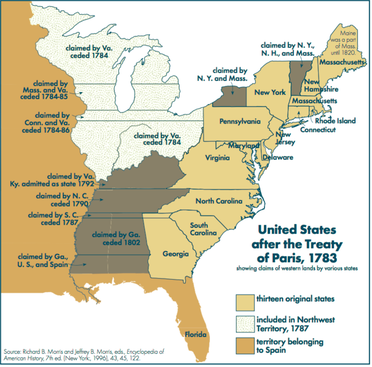|
By Kara Morrison On this day in 1795, the Treaty of Greenville was signed almost a year after General Anthony Wayne declared U.S. victory at the Battle of Fallen Timbers. The treaty marked the formal end of the Northwest Indian War. After the Revolutionary War, the U.S. government began laying out more detailed plans for defining and selling land, especially in the newly acquired Northwest Territory. While the British had treaties with many of the indigenous groups in the Northwest Territory, once they ceded the land to the U.S. in the Treaty of Paris, the U.S. government did not feel bound to these agreements. As U.S. settlers pushed westward, the government increasingly called for the removal of indigenous communities already inhabiting the Northwest Territory. Map courtesy of the Indiana Historical Society from the Encyclopedia of American History, 7th ed. by Richard B. Morris and Jeffrey B. Morris. The U.S. government continued applying pressure on indigenous leaders to cede their land, often using military force. As indigenous groups formed a British-backed confederation, known as the Western Confederacy, and became more actively and effectively resistant to U.S. military pressure and violence, the U.S responded with more force and conflict soon developed into what became the Northwest Indian War. While the Western Confederacy saw many victories for the first half of the war and negotiating attempts repeatedly took place both between indigenous leaders and between the Western Confederacy and the U.S., the last years of the war brought more forceful and well-trained U.S. troops and more defeats for the Western Confederacy. After the ultimate defeat at the Battle of Fallen Timbers, negotiations began between General Anthony Wayne and Western Confederacy leaders. The Treaty of Greenville resulted in indigenous leaders ceding much of their land to the U.S. in return for annuity payments that ultimately also gave the U.S. a significant amount of control over indigenous nations. For many indigenous groups including the Wyandots, Delawares, Shawanees, Ottawas, Chippewas, Pattawatimas, Miamis, Eel Rivers, Weas, Kickapoos, Piankeshaws, and Kaskaskias, the Treaty of Greenville signified a major loss of their homeland and way of life. Kara Morrison is a recent graduate of Kenyon College and a contributor to the Turnstone Strategies blog. She is passionate about making historical and educational information accessible to the public.
0 Comments
|
The blog is a space for stories of the natural world and the occasional post about communications and strategy.
Archives
September 2022
|

 RSS Feed
RSS Feed